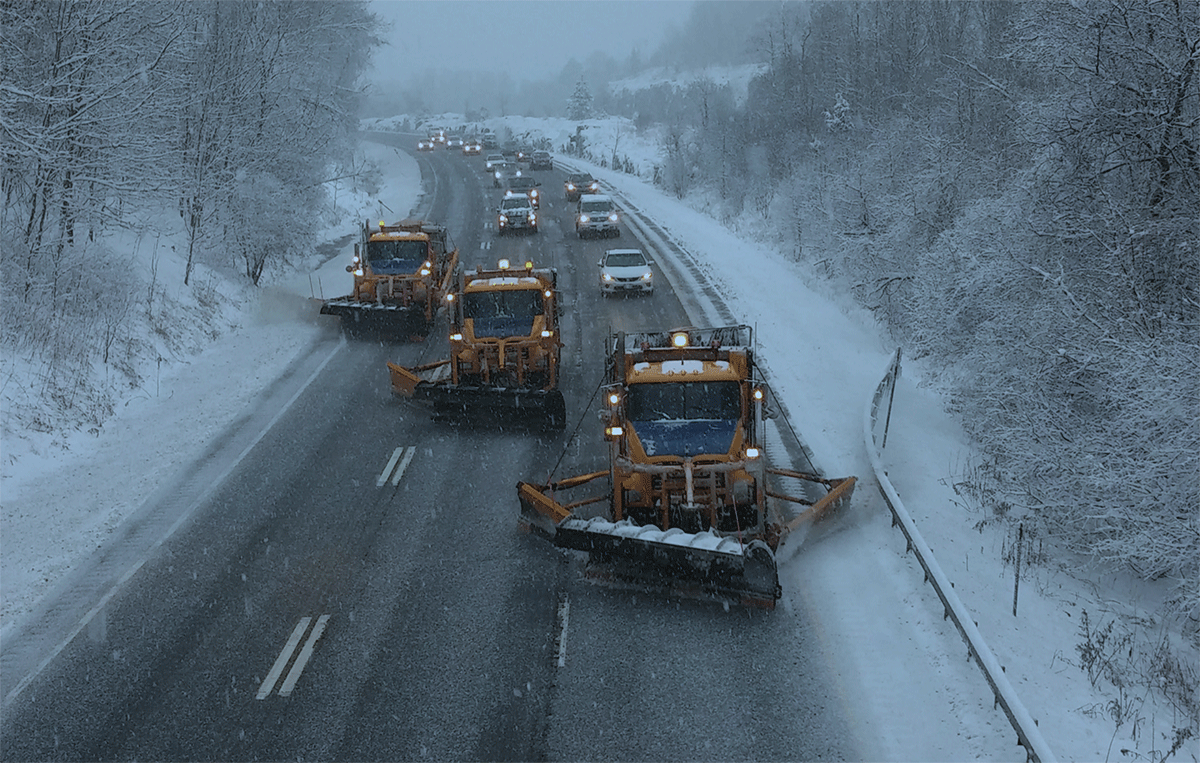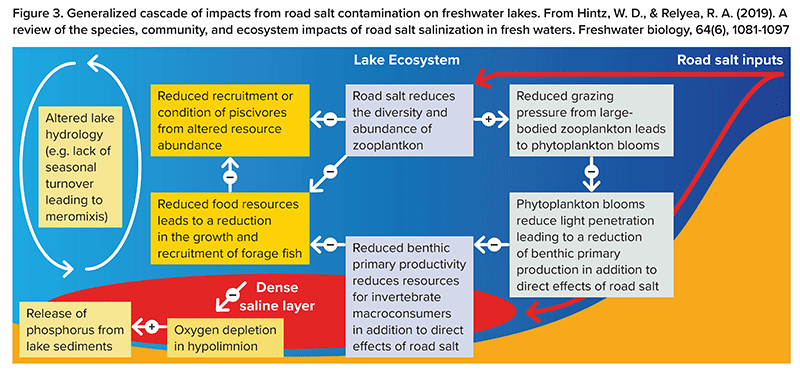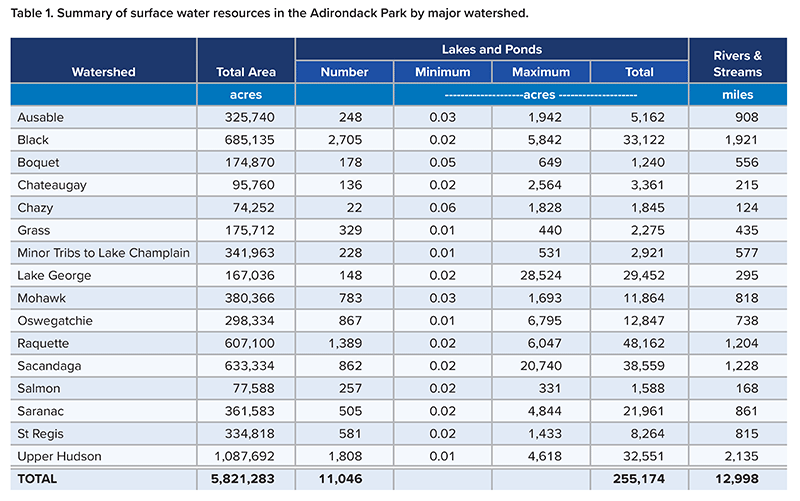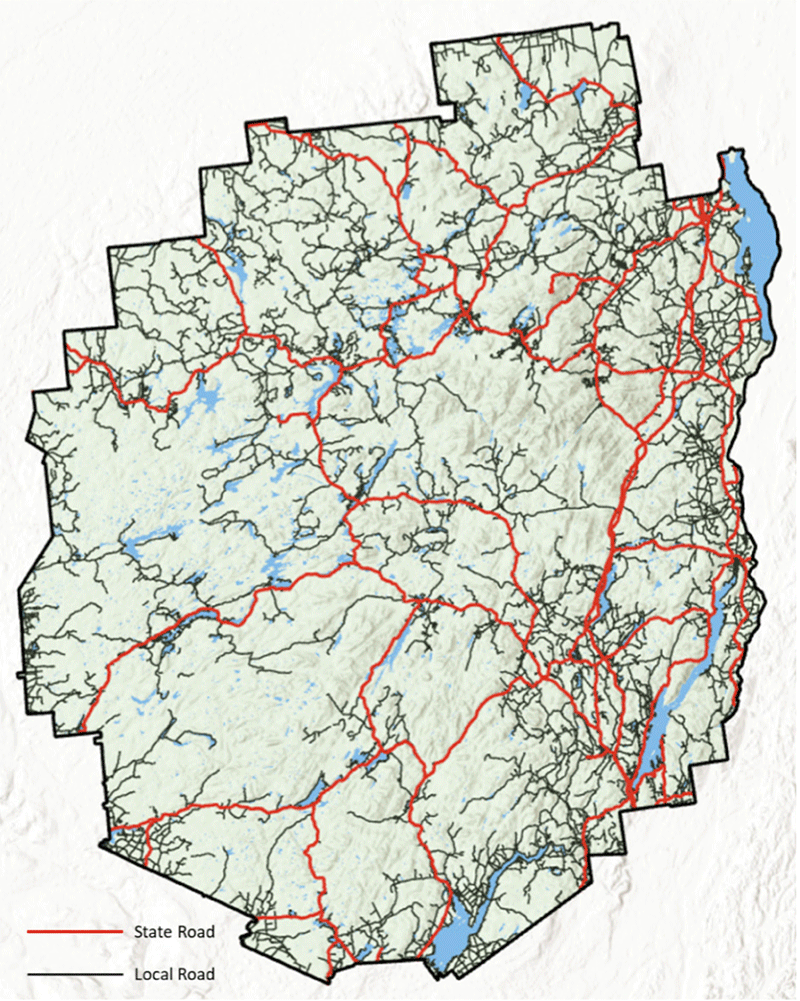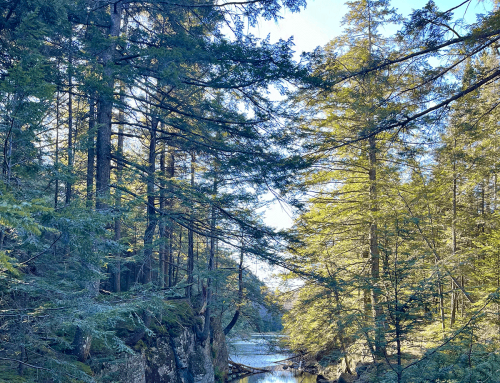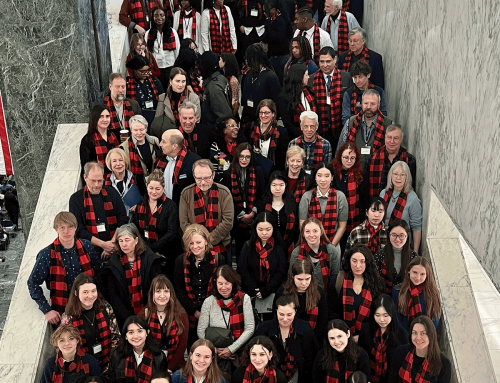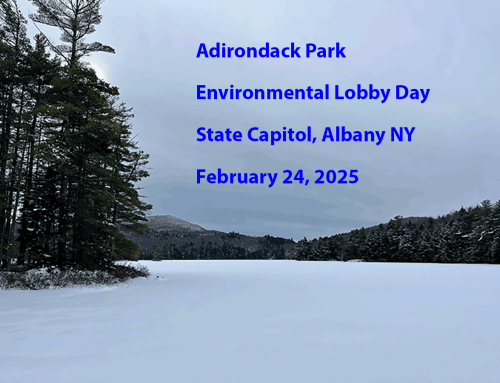New report makes the case for Adirondack highways winter snow and ice removal reforms
The long-stalled Adirondack Road Salt Reduction Task Force report was issued just after Labor Day 2023. Protect the Adirondacks had urged Governor Kathy Hochul to publish this report before the 2023-24 winter season and we applaud the Governor for pushing it out. The report provides a pathway forward for reducing road salt pollution but does not provide an operational blueprint or timetable. Nor does it empower a group to oversee the implementation of projects and policies that will reform road salt management on Adirondack roads.
Click here to read the Task Force report.
The report outlines the long-term ecological harm from salt pollution from winter roads management. The graphics in this article are all from the Task Force Report. The graphic below shows how large quantities of salt can alter natural ecosystem functions of lakes and ponds.
The report is strong on data about the importance and abundance of water in the Adirondack Park, highlighting over 11,000 lakes and ponds in 16 watersheds that include 255,000 acres of surface area and nearly 13,000 miles of streams that run for at least one mile. The report also confirms that vast amount of road salt used for winter road de-icing, estimating that over 192,000 tons of salt are used annually and spread on Adirondack roads, with over 108,000 tons used on state roads alone. The report is cautious on proposed solutions, recommending a trial-and-error approach, and it’s weak on its legal analysis and unfortunately sees the Forever Wild clause, Article 14, Section 1 in the State constitution, as a major problem to winter highway management.
The report is now in the hands of the Governor and Legislature to take it and run. Their task will be to create some kind of management entity, a commission or task force, and fund that entity through the state budget. There needs to be a central command and control entity that takes responsibility for this issue and can be held accountable. Unfortunately, responsibility and accountability are in short supply in state agencies in New York in the first decades of the 21st century. The timing of the release creates an opportunity for the next budget cycle, starting in January 2024, to set up and fund some kind of commission, but the winter of 2023-24 will see little action beyond the status quo.
In December 2020, the Randy Preston Road Salt Reduction Act was signed into law, creating the Adirondack Road Salt Reduction Task Force. The Task Force was organized in 2021, led by Department of Environmental Conservation (DEC) and Department of Transportation (DOT), and it completed its deliberations by late 2022. The report describes the long-term ecological hazards from continued high rates of salt use of Adirondack roads and points to continued problems with many roadside wells used for residential and small business water systems. The strength of the report is that there is no ambiguity in the science. The current high level of use of road salt in the winter is polluting lakes and ponds. There is also very little natural occurring chloride or sodium in Adirondack ecosystems, this is pollution we’re causing by ourselves.
The report states that the Adirondack Park contains 10,555 lane-miles of paved roads. A lane-mile as calculated by highway engineers is a mile of roadway in a single driving lane. A two-lane road running 10 miles has 20 lane miles. The report states that in the Adirondack Park the Department of Transportation manages 2,830 lane-miles (state highways and the Northway), with 7,725 lane-miles managed by local towns, villages, and counties (see map).
The report relied heavily on analysis of salt use compiled by the Adirondack Watershed Institute, our partner in the Adirondack Lake Assessment Program (ALAP), which reviewed salt contracts of state agencies and found that from 2002/03 to 2011/12, 192,700 tons of road salt was applied on average to Adirondack roads annually. This amount of salt used translates into an average of 11 tons of road salt per lane-mile for local roads and 38 tons for state roads. It’s important to note that half of all road salt used on Adirondack highways is carried off roads relatively quickly into streams, lakes, ponds and wetlands. The other half is absorbed into surrounding soils (the soil bank) and seeps gradually into the ground water, where it is carried into streams, lakes, ponds and wetlands. The report also drew heavily on the research of AWI on scores of ALAP lakes and others as well as the Darrin Fresh Water Institute on Lake George and the DEC’s CSLAP program for data about climbing salt rates in Adirondack lakes and ponds.
Click here to read the Background and Technical Assessment.
The report does not provide an overall goal for salt reduction with a number or goal to hit. Rather it sets out options to investigate possible ways to reduce salt use. The report states “Understanding how to achieve reductions in the application of road salt within the Adirondack Park requires an understanding of the intentions behind salt application. These include protecting public safety, meeting user expectations, reducing liability, managing budgets, and operating efficiently.” In short, the report may help to catalyze reform efforts, but reduction rates may take some time.
The chief recommendations include the development of reduction targets going forward, presumably this work will be done by state agencies. The report relies heavily on use of “best management practices” that focus heavily on “proven snow and ice removal policies and practices that reduce the overall quantity and frequency of salt applications while maintaining levels of service.” More training for road management staff to use less salt, greater public awareness and education about driving in areas that use less salt, more funding for both research and new equipment, better data for the public, and development of some kind of rapid response team for well contamination problems.
The Task Force also looked at various projects underway in the Adirondacks to reduced salt use and encourages more “pilot projects” in the future. These projects should be assessed as to their efficacy in reducing salt use and protecting public safety. The report calls for use of “Chloride Free Zones,” seasonal speed warnings, and use of “minimum best practices.”
The report also focuses on assessing “cold spots,” which are areas where roadside forests shade stretches of road during the winter months where snow and ice can accumulate. “Road maintenance crews often apply significantly greater amounts of road salt to these shady road corridors to provide safer driving conditions.” The report states that roads bordered by Forest Preserve are prone to cold spots. The report raises questions about managing cold spots in light of constitutional protections for the Forest Preserve.
For recommendations, the Task Force wrote:
The Task Force’s assessment addresses impacts from road salt on public health and the environment, reviews current winter road management practices, identifies training and public outreach practices to support road salt reduction targets, and provides recommendations to reduce the overall application of road salt through various best management practices. The Task Force work in these areas includes recommendations for:
- Road Salt Reduction Targets – including new water quality standards and environmental assessment and monitoring guidelines to help prevent and measure impacts to human health and the environment.
- Best Management Practices – focusing on proven snow and ice removal policies and practices that reduce the overall quantity and frequency of salt applications while maintaining levels of service.
- Snow and Ice Removal Training – providing awareness, information, and training to snow and ice removal practitioners, as well as the diversity of stakeholders who influence the rate and frequency of salt application, with a goal of broad implementation and adoption of recommended practices throughout the Adirondack Park.
- Funding – supporting and achieving the various road salt reductions strategies, best management practices, public outreach campaigns, and responding to potential contamination.
- Providing Public Access to Data and Information – informing the public and snow and ice removal practitioners on the usage of road salt across New York State to support decision-making and enhance transparency.
- Create Public Outreach and Education Campaigns – educating various target audiences on the impacts of road salt and the various strategies that can be implemented to reduce road salt usage while maintaining public safety.
- Examine Rapid Response to Surface and Groundwater Contamination – so the public will be assured there are clear mechanisms for investigations into potential contamination and a pathway to remediate identified contamination of their drinking water supplies.
The Task Force also reviewed potential pilot projects to evaluate and demonstrate the effectiveness of various road salt reduction strategies, while still ensuring the reasonable safety of the traveling public. These recommended pilots include:
- Comprehensive Analyses of Minimum Best Practices Implementation(s) within Existing Municipal Pilot(s). – To establish baseline standards for salt application policies and practices to serve as a model for all winter management operations at all levels of government to follow throughout the Adirondack Park.
- Comprehensive Analyses of Minimum Best Practice Implementation(s) within New Municipal Pilot Areas – To establish a baseline of application rates and the level(s) of service achieved when implementing current practices (a.k.a., “business as usual”).
- Managing ‘Cold Spots’ on Roadways – To develop a documented ‘Proof of Concept’ model for managing roadway “cold spots” by implementing a selective vegetation management pilot as an additional alternative to the need for frequent and excess road salt application in certain locations.
- Chloride Free Zone(s) – To develop a ‘Proof of Concept’ model that achieving safety and level of service performance expectations can be met or exceeded when implementing chloride-free deicing alternatives.
- Seasonal Speed Warnings – To develop a ‘Proof of Concept’ that weather warning signage statements provide opportunities to reduce road salt rates and the frequency of application.
- Private Properties – To develop a baseline analysis of salt applied as a benchmark for future salt reduction.
The Task Force also stated that funding is important, stating “In order to implement the recommendations included in this report, additional funding from federal, state, or local governments will be necessary.”
The report will help to spotlight the issue of road salt pollution, but now we need to move ahead with implementation. Protect the Adirondacks will advocate for the reports recommendations and work to see that an Adirondack Park Road Salt Reduction Commission gets set up or that new state legislation is passed to phase out or regulate the use of salt on roads.

